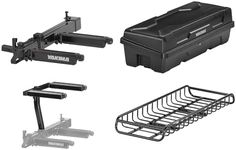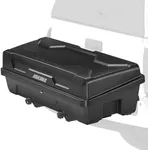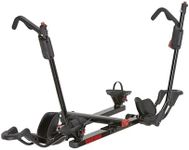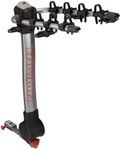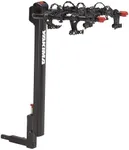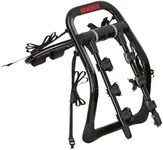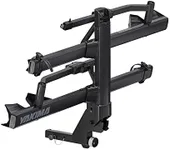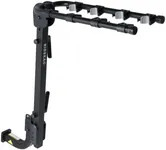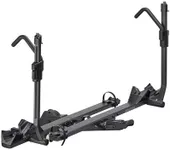Buying Guide for the Best Yakima Bike Racks
Choosing the right bike rack is essential for safely and conveniently transporting your bike. The right bike rack will depend on your vehicle type, the number of bikes you need to carry, and how often you plan to use it. Here are some key specifications to consider when selecting a Yakima bike rack to ensure it meets your needs and preferences.Rack TypeBike racks come in various types, including hitch-mounted, roof-mounted, trunk-mounted, and spare tire-mounted. The type of rack you choose will depend on your vehicle and how you prefer to load and unload your bike. Hitch-mounted racks are easy to use and can carry multiple bikes, making them ideal for frequent use. Roof-mounted racks keep your rear view clear but require lifting bikes onto the roof. Trunk-mounted racks are more affordable and easy to install but may obstruct access to the trunk. Spare tire-mounted racks are suitable for vehicles with rear-mounted spare tires. Consider your vehicle type and how often you plan to use the rack to determine the best type for you.
Bike CapacityBike capacity refers to the number of bikes a rack can carry. This is important if you need to transport multiple bikes. Racks typically range from carrying one to five bikes. If you often travel with family or friends, a higher capacity rack is beneficial. However, if you usually ride solo, a lower capacity rack may suffice. Consider your usual biking companions and choose a rack that can accommodate the number of bikes you need to transport.
CompatibilityCompatibility refers to how well the bike rack fits with your vehicle and bike. This includes the type of hitch receiver on your vehicle, the frame design of your bike, and any additional accessories like fenders or disc brakes. Ensure the rack you choose is compatible with your vehicle's hitch size (usually 1.25 or 2 inches) and can securely hold your bike's frame. Check the manufacturer's specifications to confirm compatibility with your vehicle and bike.
Ease of UseEase of use encompasses how simple it is to install, load, and unload the bike rack. Some racks come with tool-free installation and quick-release features, making them more user-friendly. Consider how often you will be mounting and dismounting the rack and bikes. If you plan to use the rack frequently, look for features that simplify the process, such as tilt mechanisms for easy trunk access and adjustable arms for different bike sizes.
Security FeaturesSecurity features are important to prevent theft of your bike and the rack itself. Look for racks with integrated locks for both the bikes and the rack. Some racks offer cable locks that secure the bike to the rack, while others have locking mechanisms that secure the rack to the vehicle. Consider the level of security you need based on where you will be parking and how long your bike will be unattended.
Durability and Build QualityDurability and build quality refer to the materials and construction of the bike rack. A well-built rack made from high-quality materials like steel or aluminum will last longer and provide better protection for your bike. Consider the conditions in which you will be using the rack, such as exposure to weather elements, and choose a rack that can withstand these conditions. A durable rack is a worthwhile investment for long-term use.
Weight CapacityWeight capacity is the maximum weight the rack can support. This is crucial if you have heavier bikes, such as electric bikes or downhill mountain bikes. Check the weight of your bike and ensure the rack can handle it. Racks with higher weight capacities are generally more robust and can support a wider range of bike types. Choose a rack that can comfortably support the weight of your bike(s) to ensure safe transportation.
